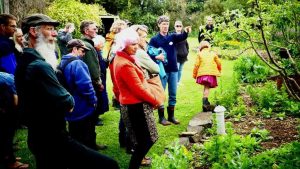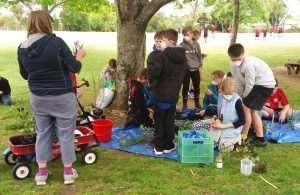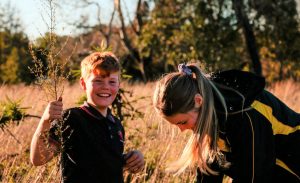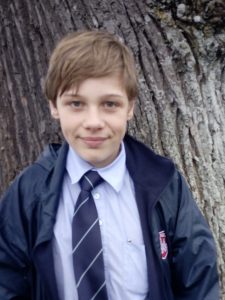Sustainability Big Idea:
Growing our own food is an important part of a resilient community. Establishing a food forest benefits present and future generations.
Building on a student’s interest in food

Robert Guyton discussing forest gardening
An exploration into food forests started in Masterton schools in 2018 when Masterton Intermediate School (MIS) student, Peyton Bold, had one of those days; he had emptied his lunchbox but not yet filled his stomach. He thought that it would be nice to have some extra food growing at school for such occasions.
MIS had recently joined Enviroschools, and teacher Hayden Walsh saw the opportunity for student empowerment and encouraged Peyton to explore possibilities related to food forests.
During his research, Peyton watched a video about a huge forest garden incorporating native trees, fruit and nut trees, shrubs, herbs, vines and perennial vegetables, created in Southland by ex-teacher Robert Guyton. Peyton loved the concept and thought a food forest was just what MIS needed. He had a lot of questions about how to make it happen which eventuated in an invitation to Robert Guyton to come to Masterton.
Getting others involved

Community workshop
The Enviroschools team quickly extended the opportunity to learn from Robert to other schools in the Wairarapa. They organised a Wairarapa-wide student workshop and a second workshop for the community, in conjunction with the Oxford Street Community Garden. Ninety people attended – the largest gathering of it’s type in Masterton.
Developing a vision with an expert

Students propagating plants
Students and adult helpers leapt at the opportunity to participate in the student workshop, attended by 25 students from seven Wairarapa schools.
Students at the workshop envisioned what the paddock at MIS could look like in twenty years time:
…”A tall canopy layer provides protection for the plants beneath it, and a home for the birds that will keep the insect life in balance. Fruit trees grow on the edges, with berry bushes below, while kiwifruit and grapevines climb up and along the branches. Herbs form an aromatic ground cover, while root veges grow plump beneath the layers of mulch”….
There was a real buzz at the workshop as participants learned about the components of a food forest, plants and their properties, propagating and planting, and “messy gardening”.
“I hadn’t really thought about growing food like that before – all the different sorts of plants you can eat and ways of growing it. I thought it was cool that a lot of it you can do for free. We’ve got some out-of-bounds areas at school and now we are looking at using some of the food forest ideas to grow stuff in those” – Student at the workshop.
Taking action
The seeds of an idea were planted with some immediate results:
“We stopped at a rest area on the way back to school and they were all out of the car, foraging around under the trees and shrubs, looking for seeds and seedlings. They also collected a whole lot of stems so they could start propagating” – Parent helper.

Bryn Gibbs, organiser of planting at MIS
Masterton Intermediate have a designated area for their food forest and have purchased materials to fence off the stream and the food forest from the school’s farm area.
They have ordered the plants for the first phase, to be planted out in winter and spring of 2019. They also hosted a large group of students for a Schools Strike 4 Climate action – a hugely successful border/riparian planting of 300 native seedlings supplied by a local residents’ association. The event also included preschoolers, students from other schools and members of the community including a group of African drummers!
Nāu te rourou, nāku te rourou, ka ora ai te iwi.
With your food basket and my food basket everyone will benefit.

Peyton Bold
“I feel so proud that I got the chance to do something like this,” says Peyton. “It was my first experience of taking action on that scale and I’d love to do something like that again. It’s so good to think that there’s going to be all that stuff that can be useful, planted right there in our paddock!”
Masterton Intermediate School became an Enviroschool in 2018, after Hayden Walsh, one of its new teachers, perceived an opportunity in the school’s curriculum.
Hayden grew up near the Waitakere ranges in West Auckland where he attended an Enviroschool. “Having these values instilled in me at a young age and seeing an organised teaching programme that incorporates these values was always attractive to me. Arriving at MIS and seeing what could be done here environmentally, particularly in such a big and influential school . . .it seemed logical to sign up, make those connections and start making changes at our school with the students.”
